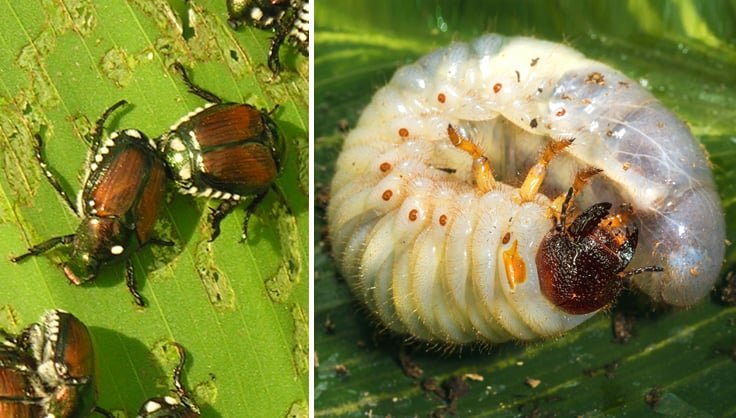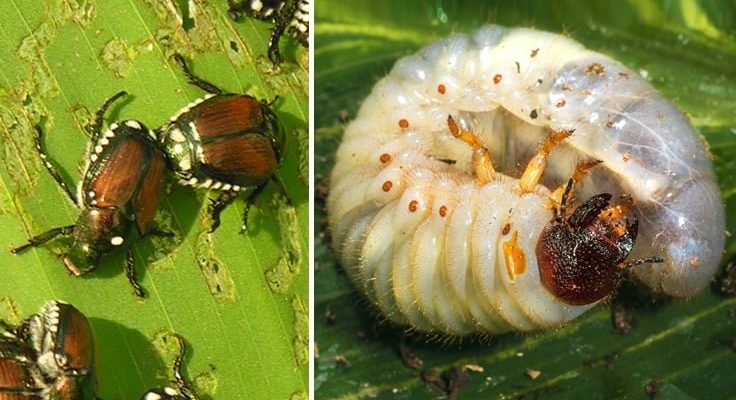
Imagine you’re digging around in your garden, and you spot a few wriggly creatures. How do you know if you’ve found a Japanese beetle grub or one of its harmless cousins? Let’s dive in to uncover the differences between **Japanese beetle grubs** and others, giving you the confidence to tackle these garden intruders head-on.
What Are Japanese Beetle Grubs?
Japanese beetle grubs are the larval stage of the adult Japanese beetle, a shiny, green insect that’s known for feasting on gardens, lawns, and orchards. These grubs typically live underground and are C-shaped, with a creamy-white body and a brown head.
They emerge from eggs laid in the soil, which hatch in late summer. The grubs will then spend the fall and winter months munching on your grass roots. By spring, they’re ready to pupate and become adults, starting the cycle all over again. And honestly, if you’ve got a lot of them, they can do some serious damage to your lawn, causing it to brown and die.
Identifying Japanese Beetle Grubs
So, how do you actually spot these grubs? First, let’s look at their physical traits. **Japanese beetle grubs** are usually about 1 to 2 inches long. They have a distinct C-shape and a noticeable brown head. One of the easiest ways to identify them is by checking for their tiny legs.
You might also notice a pattern of three pairs of legs on the sides of their body, which helps differentiate them from other grubs. To see if you’ve found a Japanese beetle larva, try gently digging around in your lawn. If you see white grubs with brown heads that curl up when disturbed, you probably have a Japanese beetle grub on your hands!
Comparing with Other Lawn Grubs
Now that you know what to look for in Japanese beetle grubs, let’s compare them with some other common lawn grubs. For instance, the **June bug grubs** are similar but usually larger and have a more pronounced “S-shape” when they’re moving.
Another common one is the **European chafer grub**, which can often be mistaken for a Japanese beetle grub. They also have a C-shape, but they tend to have a lighter color and their head is darker in comparison. In summary, here are a few key differences:
- Japanese beetle grubs: C-shaped, 1-2 inches, brown head, 6 legs.
- June bug grubs: Larger, S-shaped, darker overall.
- European chafer grubs: Lighter, C-shaped, with darker heads.
Life Cycle of Japanese Beetle Grubs
Understanding the life cycle of Japanese beetle grubs can help you manage them better. Once these grubs hatch from eggs in your soil, they start feeding on grass roots. They thrive in warm, moist soil, which unfortunately is the perfect condition for lawns during summer.
As they grow, they’ll molt multiple times, consuming all the nutrients they can. By fall, they’re ready to burrow deeper into the soil and enter dormancy for the winter. Once spring rolls around, they’ll move closer to the surface, ready to transform into adult beetles and start the cycle anew. This knowledge can help you decide when to treat your lawn for these pests, especially in late summer when they’re still active.
Why Recognizing Grubs Matters
You might be wondering why it’s so important to distinguish between Japanese beetle grubs and other types. Recognizing the right grub can guide your pest management strategies. If you identify them early, you can take action before they cause extensive damage to your lawn.
For example, treating your lawn with beneficial nematodes can effectively reduce both Japanese beetle and other grub populations. If you mistakenly apply treatments meant for other pests, you might not see any results, wasting time and money. Basically, knowing your pests means you can be a more effective gardener.
Common Control Methods
If you’ve spotted Japanese beetle grubs in your garden, don’t worry! There are several effective control methods. Here are a few to consider:
- Beneficial Nematodes: These microscopic worms target grubs specifically, making them an eco-friendly option.
- Milky Spore: This bacterial disease affects Japanese beetle grubs and helps reduce their population over time.
- Insecticides: While not the greenest option, there are specific insecticides designed to target grubs if infestations are heavy.
Always follow the manufacturer’s instructions for any treatment products to ensure safety and effectiveness.
Prevention is Key
While controlling grubs is essential, preventing them from taking hold in the first place is even better. Here are some tips to keep your lawn healthy and resistant to pest infestations:
- Maintain Healthy Soil: Regularly aerate your lawn to improve drainage and encourage healthy grass growth.
- Water Wisely: Water deeply but infrequently to promote strong root systems.
- Healthy Grass Practices: Mow at the right height and fertilize appropriately to encourage resilience against pests.
Keeping your lawn in top shape is like giving it armor against those pesky grubs.
Recognizing **Japanese beetle grubs** from other garden pests isn’t as daunting as it seems. With a bit of knowledge about their appearance and life cycle, you can confidently identify and manage these grubs before they wreak havoc in your garden. Remember, the key is observation and action. By understanding your enemy, you can better protect your lawn and garden.
So next time you’re digging around in your yard, you’ll be ready to take on any grubs that come your way. Happy gardening!

